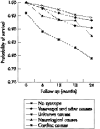Collapse query cause: the management of adult syncope in the emergency department
- PMID: 16858087
- PMCID: PMC2564156
- DOI: 10.1136/emj.2005.032136
Collapse query cause: the management of adult syncope in the emergency department
Abstract
Syncope is a commonly encountered problem in the emergency department (ED). Its causes are many and varied, some of which are potentially life threatening. A review was carried out of relevant papers in the available literature, and this article attempts to assimilate current evidence relating to ED management. While the cause of syncope can be identified in many patients, and life threatening conditions subsequently treated, a risk stratification approach should be taken for those in whom a cause is not identified in the ED. Aspects of the history and examination that may help identify high risk patients are explored and the role of investigations to aid this stratification is discussed. Identifying a cardiac cause for syncope is a poor prognostic indicator. Patients with unexplained syncope who have significant cardiac disease should therefore be investigated thoroughly to determine the nature of the underlying heart disease and the cause of syncope, although presently there is little evidence that this improves their dismal prognosis. This risk stratification approach has led to the development of several clinical decision rules, which are discussed along with current international guidelines on syncope management. This review suggests that presently the American College of Emergency Physicians guidelines are the most useful aids specific to the management of syncope in the ED; however, the Osservatorio Epidemiologico sulla Sincope nel Lazio (OESIL) score may also be a useful ED risk stratification tool.
Conflict of interest statement
Competing interests: there are no competing interests
Similar articles
-
The Risk stratification Of Syncope in the Emergency department (ROSE) pilot study: a comparison of existing syncope guidelines.Emerg Med J. 2007 Apr;24(4):270-5. doi: 10.1136/emj.2006.042739. Emerg Med J. 2007. PMID: 17384381 Free PMC article.
-
San Francisco Syncope Rule, Osservatorio Epidemiologico sulla Sincope nel Lazio risk score, and clinical judgment in the assessment of short-term outcome of syncope.Am J Emerg Med. 2010 May;28(4):432-9. doi: 10.1016/j.ajem.2008.12.039. Epub 2010 Jan 28. Am J Emerg Med. 2010. PMID: 20466221
-
Usefulness of syncope guidelines in risk stratification of syncope in emergency department.J Med Assoc Thai. 2014 Feb;97(2):173-8. J Med Assoc Thai. 2014. PMID: 24765895
-
Diagnosis and evaluation of syncope in the emergency department.Emerg Med Clin North Am. 2010 Aug;28(3):471-85. doi: 10.1016/j.emc.2010.03.007. Emerg Med Clin North Am. 2010. PMID: 20709239 Review.
-
Management of syncope in the Emergency Department.Minerva Med. 2009 Aug;100(4):259-73. Minerva Med. 2009. PMID: 19749681 Review.
Cited by
-
Utility of brain natriuretic peptide assay as a predictor of short term outcomes in patients presenting with syncope to the emergency department.Cardiovasc Diagn Ther. 2016 Jun;6(3):234-40. doi: 10.21037/cdt.2016.03.06. Cardiovasc Diagn Ther. 2016. PMID: 27280086 Free PMC article.
-
Enhanced premature ventricular contraction pulse detection and classification using deep convolutional neural network.Phys Eng Sci Med. 2023 Dec;46(4):1677-1691. doi: 10.1007/s13246-023-01329-1. Epub 2023 Sep 18. Phys Eng Sci Med. 2023. PMID: 37721684
References
-
- Morag R. Syncope. In: Peak DA, Talavera F, Halamka J, et al. eMedicine on line emergency medicine textbook. www.emedicine.com/emerg/topic876.htm
-
- Maisel W H, Stevenson W G. Syncope: getting to the heart of the matter. N Engl J Med 2002347931–933. - PubMed
-
- Thakore S B, Crombie I, Johnston M. The management of syncope in a British Emergency Department compared to recent American guidelines. Scot Med J 199944155–157. - PubMed
Publication types
MeSH terms
LinkOut - more resources
Full Text Sources
Medical


